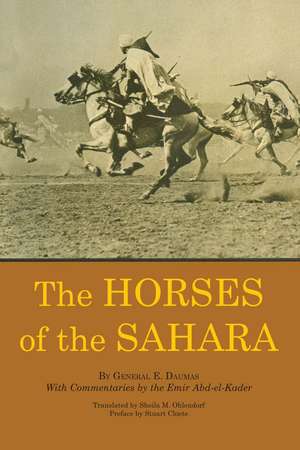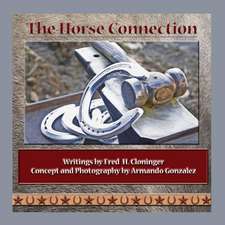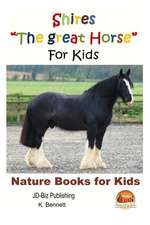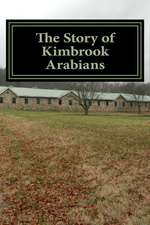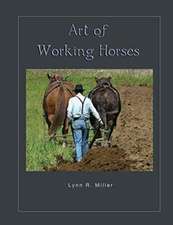The Horses of the Sahara
Autor Eugène Daumas Traducere de Sheila M. Ohlendorf Contribuţii de Stuart Cloete, Emir Abd-el-Kaderen Limba Engleză Paperback – 1968
The Horses of the Sahara will be of interest not only to equestrians but also to historians and other scholars interested in the customs of the North African desert tribes and in the complex backgrounds of European–North African relations. General Daumas took part in the conquest of Algeria by France, so distinguishing himself that he was named Director of the Bureau of Algerian Affairs in the French Ministry of War. During the campaigns and the occupation that followed, he studied and attempted to understand the native peoples, with an objectivity and sympathy unusual among the colonialists of the period. His book provides fascinating sidelights on many aspects of Arab life, including customs, superstitions, religion, and family life.
Sheila M. Ohlendorf was uniquely suited to translate The Horses of the Sahara. An excellent rider herself, thoroughly experienced with the animals and the techniques being discussed, she also spoke fluent French, having received her B.A. degree in languages from Texas Western University (now the University of Texas at El Paso). As curator of the Hall of the Horsemen, the large collection at the University of Texas at Austin, she had access to a wide variety of supplementary authorities, which enriched both her translation and the notes that accompany the book.
Preț: 232.88 lei
Nou
Puncte Express: 349
Preț estimativ în valută:
44.57€ • 46.36$ • 36.79£
44.57€ • 46.36$ • 36.79£
Carte tipărită la comandă
Livrare economică 14-28 aprilie
Preluare comenzi: 021 569.72.76
Specificații
ISBN-13: 9780292740716
ISBN-10: 0292740719
Pagini: 292
Dimensiuni: 152 x 229 x 15 mm
Greutate: 0.45 kg
Editura: University of Texas Press
Colecția University of Texas Press
ISBN-10: 0292740719
Pagini: 292
Dimensiuni: 152 x 229 x 15 mm
Greutate: 0.45 kg
Editura: University of Texas Press
Colecția University of Texas Press
Notă biografică
E. Daumas (1803-1871) was a French general and writer.
Sheila M. Ohlendorf was brought up in Mexican mining camps; attended boarding school in Edinburgh, Scotland; lived in Nassau, in the Bahamas, for two years; and has resided in Mexico, Guatemala, and Nicaragua. While engaged in research for Stuart Cloete, the South African novelist, she became interested in this book. "Mr. Cloete, writing a book on the use of the horse in war, asked me to do research for him in the Latin American field because I am bilingual in Spanish. I decided that the book would be of great interest to horsemen, particularly now that there is a tremendous interest in the Arabian horse in the United States. The Spanish translation was poor; so I obtained a copy in the original French and translated it from that language."
Sheila M. Ohlendorf was brought up in Mexican mining camps; attended boarding school in Edinburgh, Scotland; lived in Nassau, in the Bahamas, for two years; and has resided in Mexico, Guatemala, and Nicaragua. While engaged in research for Stuart Cloete, the South African novelist, she became interested in this book. "Mr. Cloete, writing a book on the use of the horse in war, asked me to do research for him in the Latin American field because I am bilingual in Spanish. I decided that the book would be of great interest to horsemen, particularly now that there is a tremendous interest in the Arabian horse in the United States. The Spanish translation was poor; so I obtained a copy in the original French and translated it from that language."
Cuprins
- Preface, by Stuart Cloete
- Acknowledgments
- Translator’s Introduction
- Preliminary Chapter. The horses of the Sahara—Sources of information—Guarantees of exactitude—Difficulty of obtaining information—Observations of the Emir Abd-el-Kader—Numerous treatises about horses written by Arabic sages.
- Chapter Two. Dealing with the origins of the Arabian horses—A singular letter written by the Emir Abd-el-Kader—Four great eras—God created the horse from the wind—The horse, according to the Koran, is the supreme blessing—The colors of horses according to the terrain in which they live—The moral attributes of horses.
- Chapter Three. The Barb or Barbary horse—Call a horse Arabian, Barb, Turk, or Persian, he is still the horse of the Orient—Letter from the Emir Abd-el-Kader—Letter from M. Ferdinand de Lesseps describing horseraces in Alexandria—Weights carried by horses in Africa.
- Chapter Four. The horses of the Sahara—Traditional love for horses as a religious duty—Proverbs—Popular verses—Observations of the Emir Abd-el-Kader—The horses of the Sahara are superior to those of the Tell.
- Chapter Five. The undoubted purity of blood of the Barbs of the Sahara—Families of Arabian horses—The perfection of the horse; the noble horse—Observations of the Emir Abd-el-Kader—Horses divided into two families: Arabian and foreign horses.
- Chapter Six. About stallions and mares—Mating—Gestation—Foaling—Care and feeding of the mare and foal—Observations of the Emir Abd-el-Kader—The foal takes after the sire—Strictness with regard to the purity of blood lines.
- Chapter Seven. The training of the colt—Very early training—Training after weaning—Exercise—Names given to horses—Observations of the Emir Abd-el-Kader.
- Chapter Eight. Feed—Camel’s and ewe’s milk—Dates—Feeding according to the season—Observations of the Emir Abd-el-Kader—Rest and fat are the enemies of the horse.
- Chapter Nine. Grooming, hygiene, and proportions—The choosing of feed and water—Methods of predetermining the height and qualities of a horse—Observations of the Emir Abd-el-Kader—Method of judging the size and future qualities of a horse.
- Chapter Ten. Colors—Attributes of certain colors—Splotches—Whorls or tufts—Favorite colors—Observations of the Emir Abd-el-Kader.
- Chapter Eleven. Selection and purchase of horses—Reasons for disqualification or elimination—Selling methods—The Arabic horse-dealer—Observations of the Emir Abd-el-Kader—Genealogical trees Poetic quotations and anecdotes.
- Chapter Twelve. Farriery—Master smith, their prerogatives, their tools—Cold shoeing—Drawbacks of European horseshoes.
- Chapter Thirteen. Tack—The Arabic saddle, et cetera—Superiority of Arabic tack.
- Chapter Fourteen. General principles of the Arabic horsemen—Frugality—Sobriety—Respect for a horse—The study of the nature of horses—Observations of the Emir Abd-el-Kader—Horseracing among the Arabs.
- Chapter Fifteen. Veterinary medicine among the Arabs—A word about the Arabic veterinary art—Veterinarian sages—Free services—Diseases of the horse—Observations of the Emir Abd-el-Kader.
- Chapter Sixteen. Gelding of the Arabian horse—Methods employed—Superstitions—Observations of the Emir Abed-el-Kader.
- Chapter Seventeen. The usefulness to be derived from the native horse—Notes on the Barb or Oriental horse—The use of the Arabian horse—Quotations from the Bible and the Koran.
- Chapter Eighteen. The Opinion of the Emir Abd-el-Kader with respect to the Arabian horse—The number of days an Arabian horse can journey—The distance covered in one day—An example of sobriety and endurance—Reasons for training horses from an early age—Why mares are more expensive—Pedigrees—Tribes which own famous horses—The homogeneity of Barbs and Arabians—Precepts for the care and feeding of the horse—Draft or work horses.
- Chapter Nineteen. The war horse—His conformation and attributes.
- Chapter Twenty. Letters to the author—Opinions of some of the leading horsemen in France—The deplorable conditions into which horse-breeding has fallen.
- Appendix
- Bibliography
- Index
Descriere
The first European-authored study of Arabian horses.
